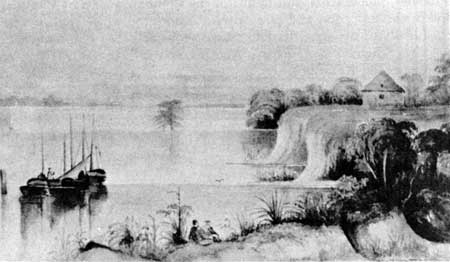|
JAMESTOWN National Historic Site |
 |
The Story of Jamestown (continued)

A watercolor by Robert M. Sully showing the
shoreline at Jamestown in 1854 at a point just above the Old Church
Tower. In this period erosion was slowly destroying the west end of the
site of "Old James Towne." (Original in the collection of the late Miss
Julia Sully, Richmond, Va.)
JAMESTOWN REBUILT. Lord Culpeper reached Virginia in May 1680, with instructions to rebuild Jamestown and to develop it into an urban center. In 1683, he was able to report that he had given all possible encouragement to this enterprise and that, although he himself was living at Green Spring, considerable activity had begun. He mentioned specifically that Nathaniel Bacon (the kinsman of the rebel), Joseph Bridget, and William Sherwood had substantial work under way. A little later the fourth statehouse was completed, as was the church. By 1697 the town had been rebuilt and boasted of a statehouse, country house, church, fort, powder magazine, and 20 or 30 houses. In this period William Sherwood, for a time attorney general for the colony, was a major landholder on the island and in the town. Others included Robert Beverley, author of one of the early histories of Virginia; William Edwards, clerk of the Council; Henry Hartwell; and John Page. It was in 1686 that John Clayton, minister at Jamestown, offered proposals for draining the marshes nearby to improve the healthfulness of the spot, a project that never materialized.
STATEHOUSE BURNED AND CAPITAL MOVED. On October 31, 1698, a fire consumed the statehouse, prison, and probably other buildings at Jamestown, although the records and papers were saved. This fire led to the removal of the seat of government to Middle Plantation (Williamsburg)—a spot favored by the Governor, Sir Francis Nicholson. Thus, Jamestown was abandoned as the seat of government after 92 years. Its mission had been accomplished, and it had seen Virginia grow from the small settlement of 1607 into a colony of great extent, with a population of perhaps 80,000.
LATER YEARS AT JAMESTOWN. The removal of the capital ultimately proved the death blow for Jamestown, for this eliminated the primary reason for its existence. Decline set in immediately, but Jamestown retained a seat in the assembly for another three-quarters of a century. Its end as a town, legally and physically, may be given as the period of the American Revolution. There was a military post here early in that struggle. Later, it became a point of exchange for American and British prisoners of war, and it featured in the maneuvers leading to the Siege of Yorktown. It witnessed the movement of Cornwallis' army across the James and was a landing and resting point for American and French soldiers being sent to join Washington's allied army.
Even before 1700, property on Jamestown Island was being consolidated into a few hands. The consolidation continued unabated after this date, and before the middle of the 18th century the major part of the island was in the hands of two families—Ambler and Travis—each of which had its own "mansion." The Travis family estate at Jamestown had grown slowly since before 1650, and Richard Ambler, of Yorktown, acquired, through marriage, the extensive Jaquelin, formerly Sherwood, holdings. After 1830, the island came under a single ownership. Under the Amblers and Travises and later owners of the island, even parts of the townsite itself became farm land and functioned as an integral part of the plantation system which earlier events at Jamestown had helped so materially to create.
The fields, and woods, and marshes lay quietly on the James for generations, contributing in a small, but important, manner to a growing country. Americans often remembered the early years of the colony and the momentous events that had taken place on the island, and joined here to commemorate the deeds of their forefathers. There was the Bicentennial of 1807, the Virginiad of 1822, the 250th anniversary in 1857, and the Tercentennial of 1907. In the years between these events there were thousands who came individually and in small groups, the famous and those now unknown. It was this remembrance and loyalty to one of its great landmarks that led to the establishment of Jamestown Island as a national historic shrine.

|

| History | Links to the Past | National Park Service | Search | Contact |
|
Last Modified: Mon, Dec 2 2002 10:00:00 am PDT |

